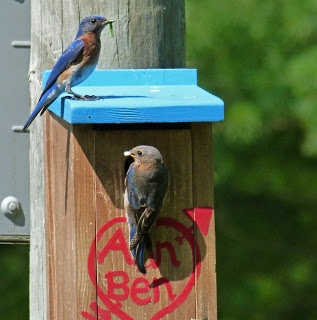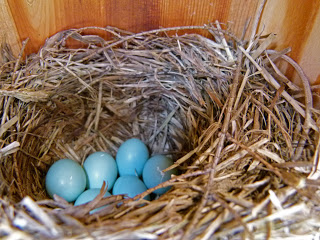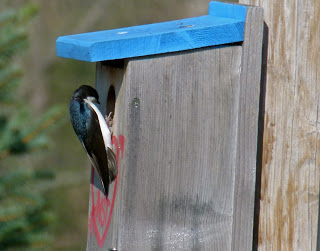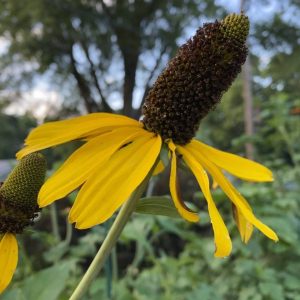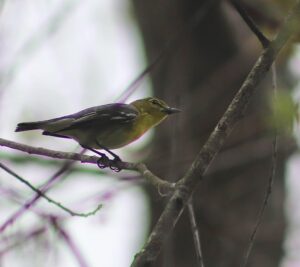Eastern Bluebirds love living at Creasey Mahan Nature Preserve. They are cavity nesters and build in boxes which the Louisville Audubon Society gave us. People donated money as a Valentine’s fundraiser that year, so some of the have people’s names or initials painted with a heart. Bluebirds eat insects when available, but I’ve seen them chowing down on mistletoe berries in the winter, and they like open grassy areas.
The CornellLab of Ornithology at Cornell University is the online authority about birds in this country, and they promote Citizen Science. That is, regular birders collect data on birds through the Christmas Bird Count, Backyard Feeder Watch, and NestWatch programs. Very clever of them to enlist thousands of field researchers at no pay! I explored the NestWatch site, and decided that the Creasey Mahan Bluebird Trail would be a terrific addition. You study a guide to learn how to monitor nests, and take a short online exam (very easy but very informative). Then you set up your nest sites online to record the data. They recommend checking the boxes every 3-4 days – is there a nest? Does it have any eggs? Are the parents around? When do the young hatch and how many? Predation losses? Are there House Sparrows or Cowbirds? One cool trick I learned is to use a mirror to see down into the nest, instead of reaching in with your hand. The eggs are quite fragile and can break with a touch sometimes.
The females will lay one egg per day when they start, and usually lay 4-5 in a clutch. This ambitious female has SIX to take care of! Sialia is the genus of Bluebirds, and Sialis is a website dedicated to them where you can learn everything you ever wanted to know about Bluebirds and other birds you might find while watching them. Bob and Judy Peak monitor Bluebird boxes around Land Between the Lakes, and they have 70-90% occupancy this year. If there isn’t a hard freeze yet to come, they think we will have a record number of Bluebirds hatching! I’m not monitoring all our boxes, but of the 15 I am watching, we have Bluebird 5 of them, and Chickadees eggs in one.
For example, a pair of Tree Swallows have nested for several years in the box just outside the Nature Center. She will line her nest with fluffy feathers and pull them over the hatchlings to keep them warm. We also have a Chickadee in one of our boxes. She uses a base of moss and lines the cup with what looks like dog fur. In any event, it’s very soft and warm.
Tree Swallows and Chickadees are nice birds just looking for a place to raise a family. But other species will use our boxes and not be nice about it. House Sparrows, for example, will not only nest in a Bluebird box, but will go into a Bluebird nest and kill both the young and adults there. House Wrens will put sticks and twigs in boxes they don’t intend to use before actually starting a nest. They have been known to destroy Bluebird and other cavity nester’s eggs by piercing them (holes of 3 mm or less, or a large ragged hole in the middle), and then often removing them from the nest. They can remove an entire chickadee nest in a matter of hours. One theory is that they are removing competition for food since they eat insects too. Cowbirds will lay eggs in the nests of other birds, so you have to keep an eye out for an egg that doesn’t match the others.
The spotted House Sparrow eggs are laid in a messy nest with pieces of paper and trash mixed with other birds feathers. The recommendation is to remove the nest. Bluebirds have been know to lay 3 clutches through the summer, so monitoring will continue for months to come, and I’ll share any exciting discoveries. But I ask you to please not disturb the nests and parents unless you are experienced with nest monitoring.

